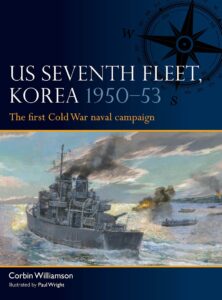Corbin Williamson, US Seventh Fleet Korea 1950-53 (Osprey, 2025)
Some still refer to the Korean War as the Forgotten War. If it is remembered, it is the ground war that garners most interest followed by the air war in the new jet age. What is too often overlooked is the role of the various navies that made up the UN force at sea. In this book, Corbin Williamson addresses that omission with a particular focus on the most powerful fleet in the world at the time, the US 7th Fleet.
Williamson begins with an overview of the 7th Fleet after World War II. He notes that the fleet remained busy even while US defence cuts took hold and foreign policy focus shifted from the Pacific to Europe. There was also internal dissension between the Air Force and the Navy over how US airpower would function. In the meantime, tensions arose on the Korean peninsula with the threat of a communist takeover. The 7th Fleet held exercises with the Royal Navy in March 1950, but the real action was just around the corner with the communist assault on the Republic of Korea.
An analysis of the 7th Fleet follows the narrative preamble. Williamson surveys the ships, including the carriers, battleships, cruisers, and destroyers, before moving onto the naval warplanes and helicopters. Williamson examines how the fleet operated, focusing on command, control, and communications. Here we find that the Navy was split into two commands in the Pacific then into three groups as the demands became clearer – Williamson helpfully includes an organisational chart to show the various changes. Williamson next describes the problems in communications caused by the increase in wartime radio traffic. The Korean War required a change in US naval doctrine and an increased need for manpower. Williamson also covers naval intelligence and logistics.
Knowing how the navy operated helps us understand what they did in combat. Williamson narrates the defence of the Pusan Perimeter in 1950. Overall naval supremacy was established quickly in the Korean War, but the main naval activity was providing air support for ground troops. Perhaps the most famous incident in the war was the landings at Inchon, facilitated by the Navy and let us not forget the pivotal role of the US Marines. Williamson adds the daring bombardment of Chinnampo to his narrative along with other evacuations of troops when the Chinese flooded over the Yalu River. In 1951 and 1952, the Navy helped interdict Chinese communications with varying degrees of success. Later, to provide an edge in peace negotiations, the Navy increased its attacks on infrastructure.
This is an informative book that adequately supports Williamson’s conclusion that the actions of the 7th Fleet demonstrated the continuing utility of the navy in a time of jets and missiles. Williamson does a good job of explaining how the fleet operated, and he takes care to include the valuable support of other national fleets in this United Nations operation. There is not much in the way of significant events to cover in this war, but Williamson brings out those that were important while describing the fleet’s almost continuous role in supporting the action on the ground. Osprey adds its usual flavourful artwork and graphics to produce a useful survey of this often overlooked aspect of an often overlooked war.
